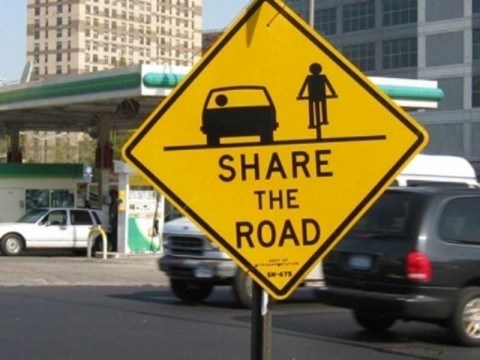Under the Motor Vehicle Act a cyclist on the road has the "same rights and duties as a driver of a vehicle," but motorists often forget that cyclists are entitled to the entire lane unless there is a safe opportunity to pass. Some drivers are passing too close or passing at inopportune times. Others, angered by the inconvenience, will honk and shout at cyclists, or drive aggressively to make a point.
The result is a growing number of close calls on Sea to Sky roadways for local riders. Concerned that someone will be seriously injured or killed, the Whistler Triathlon Club and Team Whistler have joined forces to educate both drivers and riders, and to lobby for road signs, better shoulders, and more general awareness of bicycle rights and safety issues.
"It would be nice if people were more courteous, and recognize... that we live in a recreation area," said Tony Routley. "It would be great if we could have had bike lanes on the new highway... they made the shoulders wider, but it's not always an option for us because of gravel, broken glass, pieces of car, potholes, the rumble strip. The roadway is where cyclists are allowed to be, and that's the area to the left of the white line. We're going to ride as close as we can to the line, but we're still entitled to be on the roadway. The other side of the white line is the shoulder."
Highway construction has made lanes a little tighter, which has no doubt exacerbated the problem, but Routley says the situation is getting worse on sections of road that are outside construction areas. Rather than relinquish his right to ride on the road, he's seeking a solution where drivers and cyclists are more aware of each other.
Team Whistler and the triathlon club recently attended a Sea to Sky Highway stakeholder meeting and earned a number of concessions. For one thing, the Ministry of Transportation and road contractors committed to clearing the highway shoulder of debris twice a year, which will make the shoulder a more viable option for road riders in the future. Highway contractors have also made themselves available to perform any maintenance on the shoulder if road riders call it in.
"(Mainroad) said we should call in if there's a dangerous stretch of road, and that they would go out to cold patch or clear debris," said Routley. "The way they see it, we're the ones who are out there every day and are in the best position to notice these things."
The Ministry of Transportation has also agreed to put two signs on the highway to advise motorists to share the road with cyclists. One sign will be placed on the road heading south from Pemberton, and another heading north from Function Junction.
"That's just a start," said Routley. "I know we'd like to see more signs along the whole stretch of highway from Squamish to Pemberton, and especially in Whistler where there are so many people riding bikes around."
The road cyclists have also helped put together a brochure for commercial truck drivers, which they say are becoming a major problem for cyclists. Routley says he has been run off the road several times in the past three years, and that trucks were responsible for most of those close calls. Most were accidental, large trucks drifting over the white line, but he also believes that some were deliberate; drivers sending a message to road riders.
"Some drivers will slow down, or look out their window to make eye contact. Whether it's a case of them pulling over or the truck going where they're looking I don't know but it's never fun to find yourself heading into the ditch at 40 kilometres an hour," said Routley.
Now, brochures will be available at weigh stations through Sea to Sky and the rest of the province to remind drivers of the rules. For example, drivers should avoid passing if it creates a situation where cyclists, oncoming vehicles and the truck pass each other at the same time. As well, it stipulates that trucks are required to provide a minimum buffer of one metre while passing while reaffirming that cyclists have a right to ride to the left of the white line.
The cycling groups are aware that it's a two-way street, and are reminding their members that the rules apply to them as well. Cyclists should not ride abreast of one another, for example, and should always be as far right as possible. Cyclists are also required to use hand signals at intersections to let drivers know their intentions.
As a matter of safety cyclists should also be visible, wear helmets, and take care not to ride in a vehicle's blind spot.
But while cyclists need to be aware of their rights and responsibilities, Routley says it's ultimately up to motorists to drive with care.
"If two cyclists are riding beside each other and the police see it, then they can ticket the riders... but getting angry and making the situation more dangerous is not an option. You can't hit somebody or run them off the road because they're breaking the law."




